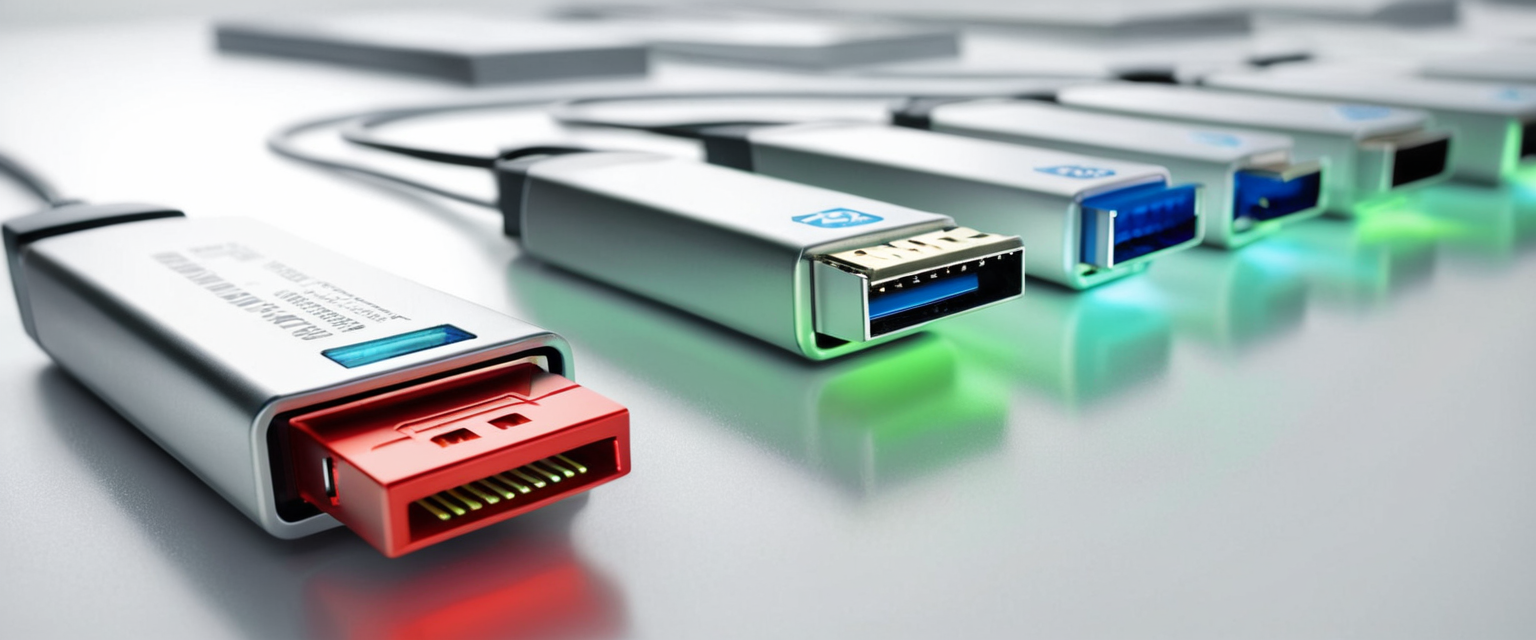
USB flash drives remain ubiquitous in modern organizations despite representing one of the most significant cybersecurity vulnerabilities facing enterprises today, particularly in highly regulated sectors such as healthcare and finance where protected health information and sensitive financial records demand exceptional protection. This comprehensive analysis examines the multifaceted security threats inherent to USB devices, evaluates the effectiveness of encryption-based mitigation strategies, and explores substantive alternatives that provide enhanced security for protecting financial and medical documents. The research reveals that while properly encrypted USB drives can provide baseline protection, organizations in regulated industries increasingly recognize that a comprehensive data protection strategy combining encryption, device management policies, employee training, and modern alternatives such as cloud-based file sharing solutions, network-attached storage, and managed file transfer systems offers substantially superior protection against the evolving threat landscape. The challenge for healthcare providers, financial institutions, and other organizations handling sensitive personal information is no longer whether USB drives should be used, but rather how to balance operational convenience with the imperative to safeguard protected health information and confidential financial data against an ever-expanding array of sophisticated threats.
The Critical Vulnerabilities and Threats Associated with USB Flash Drives
USB flash drives, despite their apparent simplicity and convenience, represent a catastrophic vulnerability vector when utilized without comprehensive security controls in organizations handling sensitive financial and medical information. The portability that makes these devices valuable—their pocket-sized form factor and near-universal compatibility across computing platforms—simultaneously creates the conditions for data compromise on an unprecedented scale. A senior systems control engineer at the Sellafield nuclear plant was terminated after dropping USB sticks containing unencrypted sensitive information in a car park, with investigation revealing that the employee had downloaded sensitive data onto personally-owned USB drives and used them on both personal computers and nuclear facility systems, demonstrating how individual negligence can create organizational catastrophe. This incident exemplifies how USB devices become vectors for both accidental data loss and deliberate insider threats, with minimal friction preventing data exfiltration.
The technical vulnerabilities embedded in USB architecture compound these human factors significantly. According to a 2022 cybersecurity report from Honeywell cited by the United States Cybersecurity and Infrastructure Security Agency, part of the Department of Homeland Security, fifty-two percent of overall threats were designed to be used in portable media, representing a dramatic increase from thirty-seven percent in 2021. This expansion of malware targeting removable media reflects the recognition among sophisticated threat actors that USB devices represent reliable attack vectors, particularly when targeting organizations with valuable intellectual property or sensitive personal information. A 2018 study from cybersecurity software company McAfee found that USB drives remain the number one data exfiltration vector in European and Asia-Pacific countries, demonstrating the persistence of this threat across global markets.
The malware delivery mechanisms specifically engineered for USB devices present particular challenges for healthcare and financial institutions that must maintain compliance with stringent regulatory frameworks. The phenomenon of “BadUSB” attacks, wherein malicious firmware is embedded directly into USB device controllers rather than relying on executable files, represents a particularly insidious threat vector that defeats traditional antivirus scanning and firewall protections. The FBI has cautioned that hackers are actively mailing BadUSB devices to targeted companies and organizations through postal systems, disguising them as gifts or official communications to encourage unsuspecting employees to connect them to network-connected systems. The hacker group FIN7 has deployed BadUSBs disguised as thank you letters and counterfeit gift cards from the U.S. Department of Health and Human Services, specifically targeting organizations in industries that hold valuable information. This sophisticated social engineering approach, combined with firmware-level malware, creates vulnerabilities that information security teams cannot easily detect through conventional network monitoring or host-based security solutions.
The insider threat dimension of USB device usage introduces an organizational vulnerability that transcends purely technical solutions. A Ponemon Institute study revealed that seventy-two percent of employees use free flash drives obtained from conferences, trade shows, and business meetings, even in organizations that explicitly offer approved USB options and maintain strict policies against personal device usage. This widespread employee behavior demonstrates a fundamental disconnect between organizational security policies and end-user compliance, creating a situation where well-intentioned security controls fail because employees circumvent them through behavioral workarounds. The same study found that nearly fifty percent of organizations confirmed that they had lost devices carrying sensitive or confidential information in the twenty-four months prior to being surveyed, suggesting that USB device loss represents not merely a theoretical vulnerability but an operational reality affecting approximately half of surveyed organizations.
For healthcare organizations specifically, USB drive incidents create acute compliance violations and operational hazards beyond simple data loss concerns. In 2017, a senior systems control engineer at the Sellafield nuclear plant who possessed unencrypted USB sticks faced termination, with investigation revealing unencrypted sensitive data downloaded onto personally-owned devices used across personal and facility computers. In Heathrow Airport in London, unencrypted USB drives led to a major breach disclosing confidential files including security measures, CCTV camera maps, security patrol timetables, and threat assessment documents. These examples from critical infrastructure and transportation sectors parallel situations faced by healthcare networks where network segmentation breaches and compromised physician credentials obtained through USB-based malware could provide attackers with access to electronic health records systems containing protected health information for potentially hundreds of thousands of patients.
Financial institutions confronting regulatory requirements around payment card data and customer financial information face analogous risks, with USB-delivered malware representing a credible vector for acquiring authentication credentials and access to payment processing systems. The continuing evolution of threats maintains persistent pressure on organizational security programs, as demonstrated by mid-2025 reports of cryptomining attacks originating from infected USB drives, with the Zephyr malware family infecting financial institutions, educational facilities, healthcare organizations, manufacturing enterprises, telecommunications providers, and oil and gas companies. These attacks demonstrate that USB-based threats remain an active concern in contemporary threat environments, not merely legacy vulnerabilities from earlier cybersecurity eras.
Real-World Incidents and the Escalating Financial Impact of USB-Related Breaches
The financial consequences of USB-related data breaches extend far beyond immediate incident response costs, encompassing notification expenses, regulatory fines, remediation efforts, litigation costs, and the less tangible but profoundly damaging impact of reputational harm. In the healthcare sector, the average cost of a data breach now exceeds ten million dollars, with the 2024 average declining modestly to $9.77 million from $10.93 million in 2023, yet remaining at historically elevated levels that represent substantial financial impact regardless of sector. For a mid-sized healthcare organization, a single USB drive incident resulting in the compromise of protected health information for a few thousand patients could easily approach or exceed the cost of an entire year’s IT security budget for many institutions.
The U.S. Department of Defense experienced what was described at the time as the “worst breach of U.S. military computers in history” in 2008, when a USB flash drive containing malicious code created by a foreign intelligence agency was plugged into a laptop attached to United States Central Command. The resulting infection, caused by the Agent.btz worm (a variant of the SillyFDC worm), spread undetected across both classified and unclassified military networks, with the Pentagon requiring nearly fourteen months of intensive remediation efforts to eliminate the malware from military systems. The infection’s ability to scan computers for data, open backdoors, and exfiltrate information to remote command-and-control servers demonstrated the critical vulnerability inherent in permitting USB devices within highly secure military networks. Attribution analysis subsequently determined that Russian civilian and military intelligence services were responsible for the Agent.btz attack. Following this incident, the Pentagon implemented organizational USB drive prohibitions and disabled the Windows autorun feature, recognizing that reactive defense measures proved insufficient when confronted with sophisticated state-sponsored USB-based attacks.
Healthcare organizations have experienced similar devastating incidents resulting from inadequate USB drive security and encryption practices. A 2017 incident at Heathrow Airport involved unencrypted USB drives containing seventy-six folders and one hundred seventy-four documents disclosing confidential security information, including details of measures used to protect the British monarchy, specifications for identification required to access restricted areas, security patrol timetables, maps pinpointing closed-circuit television camera locations, and threat assessment documents highlighting recent terror attacks and associated threat profiles. While this incident occurred at a transportation infrastructure site rather than a healthcare facility, the pattern of unencrypted data on lost USB drives applies identically to healthcare contexts, where lost unencrypted drives containing electronic health records could expose protected health information for thousands of patients.
In regulated financial sectors, HIPAA violation enforcement actions demonstrate the severity with which regulatory agencies view inadequate encryption of portable storage media. A 2017 case involving Multi-State Billing Services resulted in a $100,000 civil penalty following the theft of an unencrypted laptop computer containing protected health information affecting 2,600 individuals. A 2017 New Jersey incident involving Horizon Healthcare Services Inc. resulted in a $1,100,000 penalty following the loss of unencrypted laptop computers, with protected health information exposure affecting 3,700,000 individuals. A 2010 Connecticut case involving Health Net Inc. resulted in a $250,000 penalty following the loss of unencrypted hard drives with delayed breach notifications, affecting 1,500,000 individuals. These enforcement actions, drawn from actual HIPAA violation cases, demonstrate the regulatory environment that healthcare organizations navigate when managing portable storage media. Organizations that fail to implement appropriate encryption protections face not merely financial penalties but also mandatory remediation plans, enhanced monitoring requirements, and reputational damage that can extend for years following incident disclosure.
The global average cost of a data breach reached a staggering $4.88 million in 2024, marking a ten percent increase over 2023 levels, reflecting the intensifying sophistication and impact of cyberattacks across all sectors. This sobering statistic underscores a disturbing trend in contemporary cybersecurity: data breaches are becoming simultaneously more frequent, more sophisticated, and significantly more expensive to remediate. Organizations in healthcare and financial services face disproportionately high breach costs relative to other sectors, with healthcare experiencing the highest average breach costs across industries due to the critical operational disruption, regulatory notification requirements, affected individual notification expenses, and litigation costs associated with health information compromise.
Understanding Encryption Technologies and Their Implementation for USB Drive Protection
The landscape of encryption technologies available for protecting data on USB flash drives encompasses diverse approaches ranging from software-based encryption solutions to dedicated hardware-based implementations, each presenting distinct security characteristics, performance implications, and deployment complexities. The National Institute of Standards and Technology provides comprehensive guidance through its Special Publication 800-111, which delineates three primary classes of storage encryption techniques: full disk encryption, volume and virtual disk encryption, and file/folder encryption. Understanding the distinctions between these approaches, and the fundamental differences between software and hardware implementations, proves essential for organizations determining appropriate protection strategies for financial and medical documents.
Full Disk Encryption and Volume-Based Approaches
Full disk encryption, also known as whole disk encryption, represents the process of encrypting all data on a hard drive or removable storage device, including the operating system, with access restricted to authenticated users. Most commercial full disk encryption products employ software-based implementations that redirect the computer’s master boot record and require successful authentication before the encrypted volume becomes accessible. For removable media such as USB flash drives, volume encryption presents practical implementation challenges, as the encrypted volume is bound to the specific physical storage medium and cannot be easily transferred between devices. In contrast, virtual disk encryption creates portable encrypted containers that maintain their encryption integrity when copied from one medium to another, allowing the same encrypted container to be burned to compact discs, transferred to different USB devices, or replicated across multiple backup locations while preserving encryption.
Software-Based Encryption: Implementation, Performance, and Limitations
Software-based encryption performed through applications such as Microsoft’s BitLocker relies upon the host computer’s central processing unit to perform cryptographic operations, with encryption keys managed by the operating system or specific application software. The convenience of software-based solutions lies in their broad compatibility—BitLocker can encrypt removable drives on Windows 10, Windows 11 Pro, Enterprise, and Education editions without requiring specialized hardware modifications. Users implement software encryption by selecting encryption options through operating system file managers, establishing strong passwords distinct from other systems, and retaining recovery keys for emergency access situations. The recovery key proves critical, as loss of both the password and recovery key renders encrypted data permanently inaccessible, necessitating secure backup procedures separate from the protected data.
However, software-based encryption implementations incur significant performance degradation, particularly when protecting removable media. Tom’s Hardware testing revealed that BitLocker’s software encryption implementation can reduce solid-state drive performance by eleven to forty-five percent depending on specific hardware configurations and encryption algorithms deployed. This performance impact stems from the requirement that the host computer’s CPU dedicate resources to encryption and decryption operations while simultaneously managing routine system tasks, creating resource contention that manifests as observable slowdowns during file transfer operations. For healthcare organizations transferring large imaging files or financial institutions processing substantial datasets, such performance degradation creates operational friction that can encourage workarounds or circumvention of encryption protections.
Software encryption also presents inherent vulnerabilities related to its dependence upon the operating system layer and the security state of the host system executing encryption operations. If the host system becomes compromised by malware, rootkits, or other persistent threats, encryption keys stored in system memory or temporary files could potentially be accessed by sophisticated attackers capable of deploying advanced memory-scraping techniques or analyzing hibernation files where encryption keys might be temporarily stored. The Heartbleed vulnerability, discovered in 2014 within the OpenSSL cryptographic library, exemplified how even carefully implemented software cryptography can harbor subtle security flaws that remain undetected for extended periods, with the vulnerability allowing remote attackers to read large portions of memory containing passwords, encryption keys, and other sensitive data. Such examples demonstrate why organizations handling highly sensitive information increasingly question whether software-based encryption provides sufficient protection against determined adversaries with sophisticated capabilities.
Hardware-Based Encryption: Architecture, Security Properties, and Operational Characteristics
Hardware-based encryption performs cryptographic operations through dedicated cryptographic processors embedded within USB drives themselves, with all encryption computations occurring within secure, tamper-resistant hardware modules rather than on the host computer’s central processor. This architectural separation provides substantial security advantages by ensuring that encryption keys never leave the USB drive and are not exposed to the host computer’s memory, where they could potentially be accessed by malware attempting to capture unencrypted data or compromise encryption keys. The Kingston IronKey product line, which has served government customers, financial institutions, and healthcare organizations for decades, exemplifies enterprise-grade hardware-encrypted USB drives featuring FIPS 197 certified Advanced Encryption Standard 256-bit encryption in XTS mode. Similar solutions such as the Kanguru Defender 3000 provide FIPS 140-2 Level 3 certification with pending FIPS 140-3 Level 3 certification, with hardware encryption using 256-bit Advanced Encryption Standard providing military-grade data security.
The security architecture of hardware-encrypted drives incorporates multiple layers of protection beyond basic cryptographic encryption. Digitally signed firmware protects the integrity of the drive and ensures that no unauthorized modifications can be made to the encryption system itself—if an attacker attempts to maliciously tamper with the signed firmware, the device will no longer operate, preventing the deployment of BadUSB attacks that could compromise the drive through firmware modification. Advanced implementations include hardware-based brute force protection with secure cryptographic controllers encased in epoxy compounds that physically prevent access to the encryption hardware, ensuring that any attempt to remove the epoxy coating destroys the flash chip and renders the drive completely unusable.
Hardware-encrypted drives offer substantial performance advantages compared to software-based encryption, as dedicated cryptographic processors handle encryption and decryption operations without consuming host CPU resources or impacting system responsiveness. Testing has demonstrated that hardware-encrypted solid-state drives maintain performance levels within one to five percent of unencrypted baseline speeds, compared to the eleven to forty-five percent performance degradation observed with software-based encryption implementations. For healthcare organizations transferring large medical imaging files or financial institutions processing substantial transaction datasets, this performance preservation eliminates the operational friction that might otherwise encourage employees to seek unencrypted workarounds.
The user experience with hardware-encrypted drives differs substantially from software-based implementations, as all encryption functionality operates transparently without requiring user intervention beyond initial password establishment. When a user connects a hardware-encrypted USB drive to a computer, the device presents an authentication interface through which the user provides credentials, after which the encrypted data becomes accessible without any additional steps or configuration requirements. This simplicity reduces the likelihood that employees will circumvent encryption protections through insecure workarounds, as legitimate use of encrypted drives requires less technical knowledge and fewer configuration steps compared to software-based encryption solutions.
However, hardware-encrypted solutions present several disadvantages that merit consideration within comprehensive organizational assessments. Hardware-encrypted drives typically cost substantially more than standard USB drives, and slightly more than software-encrypted drives, representing an ongoing procurement expense that must be factored into total cost of ownership calculations. Additionally, hardware encryption implementations are static and cannot be updated following deployment—if a cryptographic algorithm vulnerability were discovered or regulatory requirements changed to mandate stronger encryption, hardware-encrypted drives deployed years earlier could not be remotely updated to meet new specifications without complete replacement. This immutability represents both a security feature, preventing unauthorized firmware modifications that could weaken security, and an operational constraint limiting flexibility to respond to evolving security landscapes.

Regulatory Compliance Frameworks Mandating Data Protection Measures
Financial and medical organizations operate within comprehensive regulatory frameworks that explicitly mandate strong encryption protections for sensitive personal information and regulated data. The Health Insurance Portability and Accountability Act establishes security requirements for electronic protected health information, requiring that covered entities and business associates implement appropriate administrative, physical, and technical safeguards to protect the confidentiality, integrity, and availability of health information. HIPAA does not mandate encryption per se, but organizations that do not implement encryption must document the specific reasons why, demonstrating that alternative security measures provide equivalent protection to encryption for data stored and transmitted.
The enforcement of HIPAA security requirements demonstrates regulatory agencies’ expectations that healthcare organizations implement strong encryption for portable storage media and removable devices. HIPAA violation penalties are divided into four tiers reflecting the nature and intentionality of violations, with penalties ranging from a minimum of $100 per violation for violations committed unknowingly to a maximum of $50,000 per violation for willful neglect that remains uncorrected. Organizations found in willful neglect tier violations face maximum annual penalties of $1.5 million per identical violation, with multiple violations potentially combining to impose penalties substantially exceeding these amounts. A 2017 HIPAA violation involving Multi-State Billing Services resulted from theft of an unencrypted laptop containing protected health information affecting 2,600 individuals, with a $100,000 civil penalty imposed. These enforcement patterns demonstrate regulatory agencies’ consistent view that failure to encrypt portable storage media represents negligent data protection inadequate for regulated healthcare organizations.
The European Union’s General Data Protection Regulation establishes comprehensive privacy and data protection obligations applicable to any organization collecting, storing, or processing personal data related to European Union citizens, regardless of the organization’s physical location. GDPR imposes obligations for organizations to implement data protection measures that address privacy and data security from the inception of system design, rather than treating security as a bolted-on afterthought. The regulation specifically requires organizations to implement encryption of personal data both at rest and in transit, representing an explicit mandate rather than permissive guidance. Penalties for GDPR non-compliance can reach four percent of annual global revenue or twenty million euros, whichever is greater, representing a substantial financial incentive for compliance across all regulated organizations.
The New York Department of Financial Services cybersecurity requirements mandate that organizations engaging in financial services in New York implement encryption of all nonpublic information, both during transmission and while stored at rest. These requirements apply not merely to cloud-based data but explicitly to portable storage media and removable devices, ensuring that encrypted USB drives or external hard drives represent compliant protection mechanisms for sensitive financial information. Financial institutions that store sensitive data on unencrypted USB drives or fail to implement appropriate encryption protections face enforcement actions, fines, and reputational damage that extends far beyond the direct regulatory penalties imposed.
Cloud-Based File Sharing and Enterprise File Sync Solutions as Primary Alternatives
Cloud-based file sharing and enterprise file sync and share solutions represent increasingly mature and sophisticated alternatives to traditional USB drive-based data transfer, offering superior security controls, audit capabilities, and compliance features that address the fundamental vulnerabilities inherent in portable removable media. Modern enterprise file sync and share platforms such as ShareFile, FileCloud, and Resilio Connect provide centralized management of file transfers and data sharing, with capabilities that encompass not merely basic file transfer but automated workflows, encryption, access controls, and comprehensive audit logging that enables organizations to maintain visibility into all data movement activities.
Managed File Transfer Solutions: Secure Automation and Compliance
Managed file transfer solutions specifically designed for enterprise environments provide substantial advantages over ad-hoc USB drive usage, particularly for healthcare and financial organizations requiring demonstrable compliance with regulatory frameworks. Managed file transfer platforms such as GoAnywhere MFT, Axway SecureTransport, and similar solutions automate the secure movement of files between systems, applications, and trading partners while providing comprehensive encryption, centralized administration, detailed audit trails, and compliance reporting features that directly address regulatory requirements. These solutions support secure file transfer protocols including SFTP (SSH File Transfer Protocol) and FTPS (FTP over SSL), implementing strong encryption algorithms such as Advanced Encryption Standard and Triple DES to protect data in transit between systems.
The SFTP protocol, which stands for SSH File Transfer Protocol, implements encryption through secure shell sessions operating over TCP port 22, with both authentication information and data being encrypted through the underlying SSH encryption layer. This unified encryption approach differs from FTPS, which implements two separate data connections and can selectively encrypt either the command channel or data channel according to organizational preferences. For healthcare organizations transferring protected health information between facilities or to external partners, SFTP’s mandatory encryption of all authentication information and transmitted data provides superior security compared to traditional FTP implementations that transmit credentials in cleartext, creating opportunities for credential compromise.
Managed file transfer solutions provide value-added features beyond basic SFTP/FTPS encryption that directly address healthcare and financial regulatory requirements. Comprehensive audit trails track every file transfer activity, with detailed logging capturing system identity, user identity, device serial numbers, dates, times, and detailed information about transferred files. These audit capabilities enable healthcare organizations to satisfy HIPAA’s requirement for audit controls that record and examine activity affecting protected health information, and enable financial institutions to satisfy similar requirements under PCI DSS and other payment card industry standards. Integration with threat protection and secure collaboration solutions provides additional layers of security beyond basic file encryption, enabling organizations to implement comprehensive data protection strategies addressing multiple threat vectors simultaneously.
Cloud Storage Solutions with HIPAA and GDPR Compliance
Modern cloud storage solutions have matured significantly to address regulatory compliance requirements for healthcare and financial organizations, providing encryption at rest and in transit, granular access controls, audit logging, and data residency options that enable compliance with HIPAA, GDPR, and other regulatory frameworks. Files.com provides military-grade Advanced Encryption Standard 256-bit encryption for data at rest and Transport Layer Security 1.2+ encryption for data in transit, with comprehensive audit trails tracking file access and transfers for compliance documentation. The platform’s cloud-native architecture automatically scales without server management requirements and provides built-in redundancy and disaster recovery capabilities that eliminate single points of failure inherent in traditional USB drive-based backup strategies.
Box offers particular value for healthcare organizations requiring the ability to securely handle DICOM medical imaging files, with built-in functionality specifically designed for the large medical file formats used in radiology and diagnostic imaging workflows. This capability addresses a healthcare-specific need that traditional USB drives and generic file sharing platforms cannot easily accommodate, as DICOM files often exceed gigabyte sizes and require preservation of metadata and image integrity that more generic file transfer mechanisms might compromise. Box’s encryption, access restrictions, audit trails, and disaster recovery capabilities provide comprehensive protection addressing the multifaceted threats inherent in uncontrolled USB drive usage.
TitanFile provides alternatives specifically designed for secure document sharing with end-to-end encryption, two-step verification, and detailed activity logs, with full compliance with ISO 27001, SOC 2 Type II, HIPAA, PIPEDA, and GDPR requirements. The platform’s flexibility in data storage location, enabling organizations to store documents in the United States, Canada, or Europe depending on specific regulatory requirements, addresses data residency obligations that constrain many healthcare and financial organizations. Two-way file transfer, secure email communication, and electronic signature capabilities enable organizations to move beyond simple file storage and implement sophisticated collaborative workflows that encompass document execution and approval processes within secure environments.
Zero-Trust File Sharing Frameworks
Emerging zero-trust file sharing approaches represent a sophisticated evolution beyond traditional file encryption, implementing principles of least privilege where users only access data they absolutely require and access must be actively enabled rather than relying on default permission models. FileCloud’s implementation of zero-trust file sharing through encrypted Zip files with password protection ensures that even if cloud storage systems are compromised, the encrypted files remain inaccessible without knowledge of specific passwords managed outside the cloud platform. The decryption key is not stored within the FileCloud system, ensuring that data protection depends not upon the security of the cloud infrastructure but upon knowledge of specific passwords known only to authorized users.
This architectural approach addresses a fundamental concern regarding cloud storage: the potential vulnerability of cloud infrastructure to compromise through advanced persistent threat campaigns, insider threats within the cloud provider organization, or nation-state intelligence gathering activities. By ensuring that decryption keys never reside within the cloud platform regardless of the sophistication of potential attackers, zero-trust file sharing frameworks provide protection that transcends the security of the cloud infrastructure itself. Users can share sensitive files through standard cloud links while maintaining confidence that unauthorized access to cloud systems could not result in data exposure without knowledge of specific passwords communicated through separate, secure channels.
Network-Attached Storage and Local Storage Alternatives
Network-Attached Storage systems represent another important alternative to USB drives for organizations requiring centralized file storage with sophisticated backup, recovery, and security capabilities. NAS devices connected to organizational networks enable multiple users to access and share files over standard network protocols while providing centralized management of access controls, encryption, backup scheduling, and disaster recovery functionality. Rather than relying on individual employees to maintain portable USB drives with copies of sensitive information, NAS-based approaches centralize data storage in secure, managed infrastructure with professional-grade redundancy and recovery capabilities.
NAS systems provide substantial advantages for healthcare and financial organizations through features specifically addressing regulatory compliance requirements. RAID (Redundant Array of Independent Disks) configurations store data across multiple physical drives, ensuring that single drive failures do not result in data loss—redundancy that USB drives, despite their portability, fundamentally cannot provide. Automated backup scheduling creates regular copies of protected data without requiring manual intervention from end users, reducing the likelihood that negligence or employee forgetfulness results in critical data being unprotected. NAS systems typically include file lockdown capabilities implementing immutable storage volumes that prevent editing, overwriting, and deletion of stored data for specified retention periods, making stored data completely resistant to ransomware attacks that attempt to encrypt or delete files.
The implementation of immutable file storage volumes addresses one of the most significant contemporary threats to healthcare and financial organizations: ransomware attacks designed to encrypt or delete backup data to maximize organizational pressure to pay extortion demands. The Cybersecurity and Infrastructure Security Agency explicitly recommends immutable storage as a means to mitigate ransomware risks, recognizing that traditional backup approaches that permit data modification become vulnerable to advanced ransomware variants specifically designed to locate and corrupt backup systems. Organizations implementing NAS systems with immutable file storage can store sensitive information with confidence that ransomware deployed against production systems cannot traverse network connections to corrupt protected backup copies stored in immutable volumes with write-protection and deletion restrictions.
Personal cloud drives represent a specialized category of NAS-like devices designed for smaller organizations or departmental use, providing cloud-style synchronization features without requiring reliance upon commercial cloud storage providers. Products such as WD My Cloud or Synology BeeDrive behave similarly to Dropbox or Google Drive but store data on hardware located within organizational premises rather than within third-party cloud infrastructure. This approach preserves the convenience of cloud-style synchronization and automatic backups while maintaining organizational control over data storage locations and avoiding transmission of sensitive health or financial information through external internet connections potentially subject to monitoring or interception.
The 3-2-1 backup strategy provides a proven framework for utilizing NAS and local storage alternatives in conjunction with offsite copies to achieve comprehensive data protection addressing multiple failure scenarios. This strategy requires maintaining three copies of important data on two different types of storage media with one copy stored offsite, creating redundancy that protects against device failures, natural disasters, human error, and cyberattacks including ransomware. An example implementation would store original data on a primary computer, maintain a second copy on an external hard drive or NAS device, and maintain a third copy in cloud storage, ensuring that no single point of failure could result in complete data loss. This comprehensive approach eliminates the single point of failure represented by individual USB drives while distributing copies across geographically dispersed locations and multiple storage media types.
The evolution toward 3-2-1-1-0 and 4-3-2 backup strategies reflects growing recognition that ransomware and sophisticated cyberattacks require enhanced protection beyond the baseline 3-2-1 approach. The 3-2-1-1-0 strategy incorporates an air-gapped offline copy and extends the framework to encompass zero errors through daily monitoring and regular restore testing. The 4-3-2 approach requires four copies of data stored in three separate locations, typically including on-premises storage, storage with a managed service provider, and cloud storage with a different provider, ensuring that compromise of any single location cannot result in loss of all copies. These enhanced strategies address the reality that contemporary ransomware campaigns specifically target multiple backup locations and sophisticated attackers spend weeks or months preparing attacks to identify and compromise all accessible backup systems.

Air-Gapped and Immutable Backup Strategies for Comprehensive Protection
Air-gapped backups represent a security measure employing physical isolation from other devices and networks to prevent unauthorized access to sensitive information, with data stored on removable media completely disconnected from networked systems. This architectural approach protects backup data from ransomware deployed against production systems, as malware cannot traverse network connections to corrupt or encrypt backups when those backups exist on physical media disconnected from any networks. Tape storage has traditionally served as the primary air-gap backup medium, with backup data written to physical tape media that can then be physically removed from storage devices and placed into secure, offline storage facilities.
The operational reality of air-gapped backups involves manual interaction with physical media, with backup data transferred to external storage and subsequently disconnected from all networks, creating complete physical separation between active data and protected backups. This manual aspect, which might appear operationally burdensome in contemporary “always-on” IT environments, actually represents the fundamental security feature that protects air-gapped backups from ransomware and other network-based threats. Organizations implementing air-gapped backup strategies store encrypted backups in secure physical locations with restricted access, often supplemented by tamper-evident packaging that indicates unauthorized access attempts, creating organizational controls that transcend purely technical security measures.
Immutable backup strategies complement air-gapped approaches by preventing modification or deletion of backup data through technical controls that persist regardless of network isolation status. Immutable storage implementations ensure that data cannot be altered or deleted until specified retention periods expire, with deletion occurring automatically after retention requirements are satisfied. Cloud object storage services implementing S3 Object Lock, Veeam Hardened Repository, and similar solutions provide immutable backup capabilities across cloud-based infrastructure, enabling organizations to maintain immutable copies in cloud environments without requiring manual media management associated with traditional tape backup systems.
The distinction between air-gapped and immutable backup strategies reflects different threat models and organizational requirements. Air-gapped backups provide ultimate isolation and protection against network-based threats but incur higher operational costs for media handling, vendor storage management, and typically longer recovery time objectives as physically stored media must be retrieved and restored, potentially requiring hours or days for complete data recovery. Immutable backups typically provide faster recovery times through online accessibility while still protecting against ransomware through technical controls preventing data modification, with the trade-off that immutable backups remain network-accessible and therefore potentially vulnerable if cloud provider security controls are compromised. Organizations implementing comprehensive data protection strategies increasingly employ both approaches, utilizing immutable backups for rapid recovery from most incidents while maintaining air-gapped offline copies as the ultimate protection against catastrophic scenarios involving compromise of all online systems.
Device Management, Access Control, and Policy Implementation
Comprehensive USB drive security requires organizational policies explicitly governing authorized portable storage device usage, with enforcement mechanisms ensuring compliance across all organizational units and user populations. Microsoft Defender for Endpoint provides technical mechanisms for controlling access to USB devices through device control policies that enable security teams to prevent users from installing or using unauthorized devices, restrict access to only BitLocker-encrypted devices, or allow specific approved devices while blocking all others. Device control policies define specific access rules for removable media, enabling granular permissions distinguishing between device read operations, device write operations, device execute operations, and file operations on external storage.
Organizations implementing USB device control policies must balance security requirements against operational productivity, as overly restrictive policies that block all USB access may prevent legitimate work activities while encouraging employees to seek unauthorized workarounds. Recommended approaches provide employees with approved, hardware-encrypted USB drives issued by the organization, implementing group policy or endpoint security controls that whitelist specific device identifiers while blocking all unauthorized USB devices. This approach preserves employee productivity while ensuring that all portable storage activity occurs through encrypted, managed devices subject to organizational oversight and audit logging.
The human factors surrounding USB drive policy compliance prove as significant as technical controls, with organizational studies demonstrating that seventy-two percent of employees use free flash drives obtained from conferences, trade shows, and business meetings despite explicit organizational policies and availability of approved alternatives. This widespread policy violation reflects fundamental human behavior patterns including inattention to security policies perceived as inconvenient, acquisition of convenient alternatives in informal settings, and beliefs that personal responsibility for data security is overstated. Effective USB drive policies require comprehensive employee training programs explicitly communicating risks associated with unauthorized USB device usage, explaining the security rationale underlying policy restrictions, and ensuring that all employees understand the organization’s expectations regarding appropriate portable media handling.
Training programs prove most effective when integrated into broader security awareness initiatives that address password management, social engineering risks, incident reporting procedures, and other dimensions of organizational information security culture. Research demonstrates that organizations with comprehensive training programs see substantially higher policy compliance rates compared to organizations relying solely upon technical controls or written policies without accompanying education. Annual refresher training programs ensure that security messages remain salient in employee consciousness and accommodate new employees unfamiliar with organizational security requirements.
Comprehensive Implementation Strategy: Integration of Multiple Security Layers
Organizations protecting sensitive financial and medical information most effectively employ layered security strategies integrating multiple complementary controls rather than relying upon any single technology or approach to address USB drive risks. This defense-in-depth methodology recognizes that sophisticated threats and determined insiders can circumvent individual controls, and that comprehensive protection requires multiple defensive barriers that together create organizational resilience against multifaceted threats. An effective implementation strategy would integrate the following elements working synergistically to address USB drive risks:
Technical Controls Layer: Hardware-encrypted USB drives for approved portable storage usage, encrypted with FIPS 197 certified Advanced Encryption Standard 256-bit encryption and FIPS 140-2 or FIPS 140-3 Level 3 certification, providing baseline protection for any USB-based data movement that remains necessary despite alternative solutions. Device control policies limiting USB device connections to whitelisted approved devices, with audit logging capturing all USB connection attempts and file transfer activities for regulatory compliance and forensic investigation following security incidents. Endpoint detection and response solutions monitoring for anomalous USB device usage patterns, unauthorized data transfer attempts, or malware introducing BadUSB-based threats that circumvent standard antivirus protections.
Alternative Solutions Implementation: Deployment of managed file transfer platforms such as GoAnywhere MFT or Axway SecureTransport for routine business-to-business file exchanges, implementing encrypted SFTP and FTPS protocols with comprehensive audit trails satisfying HIPAA and PCI DSS compliance requirements. Implementation of cloud-based file sharing solutions with HIPAA and GDPR compliance certifications for collaborative document workflows, with zero-trust encryption frameworks ensuring that even cloud infrastructure compromise could not result in unauthorized data access. Deployment of Network-Attached Storage systems with immutable file storage capabilities for centralized backup and recovery, eliminating reliance upon individual employees maintaining portable data copies and implementing automated backup scheduling, RAID redundancy, and immutable storage protection against ransomware.
Policy and Process Layer: Comprehensive USB device usage policies explicitly prohibiting unauthorized portable storage media usage, establishing clear governance for approved device procurement, authorized personnel and purposes, and mandatory encryption requirements for all portable storage media. Procedures for USB device provisioning, usage, storage, sanitization, and destruction ensuring secure lifecycle management from initial deployment through end-of-life disposal. Documentation requirements ensuring audit trails for all decisions regarding USB device authorization, usage parameters, and security oversight, supporting regulatory compliance and incident investigations.
Training and Awareness Layer: Comprehensive employee training programs communicating USB drive risks in the context of financial and medical data protection, explaining specific regulatory requirements regarding portable storage media encryption, and reinforcing organizational policies regarding approved alternatives. Regular refresher training ensuring security messages remain salient and accommodating new employees unfamiliar with organizational requirements. Leadership communication emphasizing executive commitment to information security and holding managers accountable for USB policy compliance within their departments.
Monitoring and Enforcement Layer: Continuous monitoring of USB connection attempts, file transfer activities, and policy compliance metrics to identify potential policy violations requiring corrective intervention. Incident response procedures for unauthorized USB usage violations, insider threat indicators, or suspected malware infections originating from USB-based delivery mechanisms. Regular policy audits and compliance assessments ensuring that organizational practices align with written policies and identifying gaps requiring additional controls or training.
Embracing Secure Alternatives: A Concluding Thought
The fundamental vulnerabilities inherent to USB flash drives—their portability enabling convenient but uncontrolled data movement, their susceptibility to malware targeting removable media, their ease of loss or theft, and their potential for insider data exfiltration—demonstrate why organizations protecting sensitive financial and medical information increasingly recognize that USB drives represent an operational burden rather than a security solution. The evolution of threats targeting USB devices, from simple malware delivery mechanisms to sophisticated firmware-level BadUSB attacks and state-sponsored intelligence campaigns, has outpaced the maturation of protection technologies, creating a persistent vulnerability that encryption alone cannot adequately address without comprehensive organizational controls limiting USB device usage and providing superior alternatives.
However, the complete elimination of USB drive usage remains impractical for many organizations due to legitimate use cases requiring portable data movement between isolated systems, transfer of files to external parties lacking secure connection capabilities, or temporary storage needs where more complex solutions prove uneconomical. The appropriate organizational response involves implementing a comprehensive strategy acknowledging that while some USB drive usage may remain necessary, such usage should represent the exception rather than the norm, implemented only under controlled circumstances with appropriate encryption, audit logging, and policy restrictions ensuring that USB-based data movement does not create vulnerabilities unacceptable within regulated industries.
The financial and medical organizations best positioned to protect sensitive information employ multi-layered security strategies incorporating hardware-encrypted USB drives for the limited portable storage usage that remains necessary, comprehensive deployment of managed file transfer solutions for business-to-business data exchanges, cloud-based file sharing for collaborative workflows with HIPAA and GDPR compliance certifications, and Network-Attached Storage systems with immutable backup capabilities for centralized data protection. These complementary approaches, supported by comprehensive policy frameworks, employee training programs, technical monitoring, and incident response procedures, create organizational resilience that USB drives alone, even when properly encrypted, cannot achieve.
The regulatory environment continues evolving toward more stringent encryption requirements, with GDPR, HIPAA, PCI DSS, and similar frameworks increasingly treating encryption as a foundational requirement rather than optional best practice. Organizations that proactively transition away from USB-based data movement toward secure alternatives position themselves advantageously to accommodate evolving regulatory requirements without requiring emergency remediation efforts. The financial and operational costs of establishing modern file transfer infrastructure, cloud storage deployments, and Network-Attached Storage systems represent investments in organizational security resilience that protects against not merely USB drive-related risks but the broader spectrum of contemporary cybersecurity threats including ransomware, insider threats, and nation-state intelligence gathering.
Protect Your Digital Life with Activate Security
Get 14 powerful security tools in one comprehensive suite. VPN, antivirus, password manager, dark web monitoring, and more.
Get Protected Now





